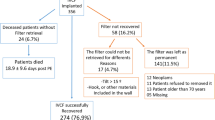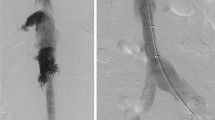Abstract
Purpose
We evaluated the Gunther Tulip (GT) retrievable inferior vena cava (IVC) filter with regard to indications, filtration efficacy, complications, retrieval window, and use of anticoagulation.
Method
A retrospective study was performed of 147 patients (64 men, 83 women; mean age 58.8 years) who underwent retrievable GT filter insertion between 2001 and 2005. The indications for placement included a diagnosis of pulmonary embolism or deep venous thrombosis with a contraindication to anticoagulation (n = 68), pulmonary embolism or deep venous thrombosis while on anticoagulation (n = 49), prophylactic filter placement for high-risk surgical patients with a past history of pulmonary embolism or deep venous thrombosis (n = 20), and a high risk of pulmonary embolism or deep venous thrombosis (n = 10). Forty-nine of the 147 patients did not receive anticoagulation (33.7%) while 96 of 147 patients did, 82 of these receiving warfarin (56.5%), 11 receiving low-molecular weight heparins (7.58%), and 3 receiving antiplatelet agents alone (2.06%).
Results
Filter placement was successful in 147 patients (100%). Two patients had two filters inserted. Of the 147 patients, filter deployment was on a permanent basis in 102 and with an intention to retrieve in 45 patients. There were 36 (80%) successful retrievals and 9 (20%) failed retrievals. The mean time to retrieval was 33.6 days. The reasons for failed retrieval included filter struts tightly adherent to the IVC wall (5/9), extreme filter tilt (2/9), and extensive filter thrombus (2/9). Complications included pneumothorax (n = 4), failure of filter expansion (n = 1), and breakthrough pulmonary embolism (n = 1). No IVC thrombotic episodes were recorded.
Discussion
The Gunther Tulip retrievable filter can be used as a permanent or a retrievable filter. It is safe and efficacious. GT filters can be safely retrieved at a mean time interval of 33.6 days. The newly developed Celect filter may extend the retrieval interval.




Similar content being viewed by others
References
Hann C, Streiff M (2005) The role of vena caval filters in the management of venous thromboembolism. Blood Rev 19:179–202
Virchow RLK (1998) Thrombosis and emboli. Science History Publications, Canton, MA, USA
Trouseau A (1865) Phlegmasia alba dolens. Clinique Medicale de l’hotel dieu de Paris, vol 3. Bailliere, Paris, pp 654–712
Greenfield LJ, Proctor MC (2000) The percutaneous Greenfield filter: Outcomes and practice patterns. J Vasc Surg 32:888–893
Stein PD, Kayali F, Olsen RE (2004) Twenty-one year trends in the use of inferior vena cava filters. Arch Intern Med 164:1541–1545
Athanasoulis CA, Kaufmann JA, Halpern EF, et al. (2000) Inferior vena caval filters: Review of a 26 year single center clinical experience. Radiology 216:54–66
Girard P (2002) Medical literature and vena cava filters: So far so weak. Chest 122:963–967
Imberti D, Bianchi M, Farina A (2005) Clinical experience with retrievable vena cava filters: Results of a prospective observational multicenter study. J Thromb Haemost 3:1370
Neuerburg JM, Gunther RW, et al. (1997) Results of a multicenter study of the retrievable Tulip Vena Cava Filter. Cardiovasc Intervent Radiol 20:10–16
Terhaar OA, Lyon SM, Given MF, et al. (2004). Extended interval for retrieval of Gunther Tulip filters. J Vasc Interv Radiol 15:1257–1262
Wallace Ml, et al. (2004) Use of inferior vena caval filters and survival in patients with malignancy. Cancer 101:1902–1907
Rosenthal D, Wellons ED, Lai KM, et al. (2005) Retrievable inferior vena caval filters: Early clinical experience. J Cardiovasc Surg 45: 163–166
Rectenwald JE (2005) Vena cava filters: Uses and abuses. Semin Vasc Surg 18:166–175
Kaskarelis IS, Chlapoutaki M, Skarpalezos DE, et al. (2006) Clinical experience with Gunther temporary inferior vena cava filters. Clin Imaging 30:108–113
Grande WJ, Trerotola SO, Reilly PM, et al. (2005) Experience with the recovery filter as a retrievable inferior vena cava filter. J Vasc Interv Radiol 16:1189–1193
Lipman JC (2005) Removal of vena caval filter at 224 days. South Med J 98:556–558
Joels CS, Sing RF, Heniford BT (2003) Complications of inferior vena cava filters. Am Surg 69:654–659
Linkins LA, Choi PT, Douketis JD (2003) Clinical impact of bleeding in patients taking oral anticoagulant therapy for venous thromboembolism: A meta analysis. Ann Intern Med 163:1285–1293
Kinney TB (2003) Update on inferior vena cava filters. J Vasc Interv Radiol 14:425–440
Wicky S, Doenz F, Meuwly JY, et al. (2003) Clinical experience with retrievable Gunther Tulip vena caval filters. J Endovasc Ther 10:994–1000
Neuerburg JM, et al. (1997) Results of a multicenter study of the retrievable Tulip vena cava filter: Early clinical experience. Cardiovasc Intervent Radiol 20:10–16
Millward S, Oliva V, Bell SD, et al. (2001) Gunther Tulip retrievable vena cava filter: Results from the Registry of the Canadian Interventional Radiology Association. J Vasc Interv Radiol 12:1053–1058
Neuerburg JM, Handt S, Beckert K, et al. (2001) Percutaneous retrieval of the Tulip vena cava filter: Feasibility, short and long-term changes. An experimental study in dogs. Cardiovasc Intervent Radiol 24:418–423
Mohan CR, Hoballah JJ, Sharp WJ, et al (1998) Comparative efficacy and complications of vena caval filters. J Vasc Interv Radiol 9:594–601
Decousus H, Leizorovicz, Parent F, et al (1998) A clinical trial of vena caval filters in the prevention of pulmonary embolism in patients with proximal deep vein thrombosis. Prevention du Risque d’Embolie Pulmonaire par Interruption Cave Study Group. N Engl J Med 338:409–441
Crochet DP, et al. (1999) Long term follow up of Vena Tech LGM filter: predictors and frequency of caval occlusion. J Vasc Interv Radiol 10:137–142
Asch MR (2002) Initial experience in humans with a new retrievable inferior vena cava filter. Radiology 225:835–844
Gunther RW, et al. (2005) New optional IVC filter for percutaneous retrieval: In vitro evaluation of embolus capturing efficiency. Rofo 177:632–636
Author information
Authors and Affiliations
Corresponding author
Rights and permissions
About this article
Cite this article
Looby, S., Given, M., Geoghegan, T. et al. Gunther Tulip Retrievable Inferior Vena Caval Filters: Indications, Efficacy, Retrieval, and Complications. Cardiovasc Intervent Radiol 30, 59–65 (2007). https://doi.org/10.1007/s00270-006-0093-9
Published:
Issue Date:
DOI: https://doi.org/10.1007/s00270-006-0093-9




